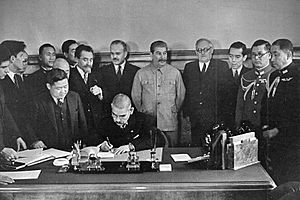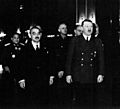Yōsuke Matsuoka facts for kids
Quick facts for kids
Yōsuke Matsuoka
松岡 洋右 |
|
|---|---|

Matsuoka in 1932
|
|
| Minister of Foreign Affairs Empire of Japan |
|
| In office July 22, 1940 – July 16, 1941 |
|
| Monarch | Shōwa |
| Preceded by | Hachirō Arita |
| Succeeded by | Teijirō Toyoda |
| Personal details | |
| Born | March 4, 1880 Hikari, Yamaguchi, Empire of Japan |
| Died | June 27, 1946 (aged 66) Sugamo Prison, Tokyo, Occupied Japan |
| Spouse | Ryuko Matsuoka (Shin) |
| Children | Kenichiro Kaneko Yoji Hiroko (adopted niece) |
| Parents | Sanjuro Matsuoka Yū Matsuoka (Ogawa) |
| Education | Meiji University University of Oregon |
| Occupation | Diplomat, Cabinet Minister |
Yōsuke Matsuoka (松岡 洋右, Matsuoka Yōsuke, March 4, 1880 – June 27, 1946) was an important Japanese diplomat and the Minister of Foreign Affairs for the Empire of Japan. He held this role during the early parts of World War II.
Matsuoka is well-known for a strong speech he gave at the League of Nations in February 1933. This speech led to Japan leaving the organization. He also helped create two important agreements: the Tripartite Pact and the Soviet–Japanese Neutrality Pact. These agreements were made just before World War II began.
Contents
Early Life and Education
Yōsuke Matsuoka was born on March 4, 1880, in Kumage District, Yamaguchi Prefecture, Japan. His family was involved in the shipping business. When he was 11, his father's business faced problems.
Moving to the United States
In 1893, Matsuoka traveled to the United States with a cousin. He went there to study English, supported by Methodist missionaries. He first lived in Portland, Oregon, at the Methodist Mission. Later, he stayed with the Dunbar family, where Mrs. Isabelle Dunbar Beveridge became like a foster mother to him. She helped him get used to American life.
School and Studies
Matsuoka went to Atkinson Grammar School in Portland. Influenced by the Dunbar family, he became a Presbyterian Christian. He was baptized and took the name "Frank Matsuoka." He later moved to Oakland, California, and attended Oakland High School.
He then returned to Portland and studied law at the University of Oregon law school. He paid for his studies by working various jobs, like a busboy and an interpreter. Matsuoka graduated from law school in 1900. He returned to Japan in 1902 because his mother was not well.
Beginning a Diplomatic Career
After returning to Japan, Matsuoka wanted to join the government. In 1904, he passed the Foreign Service exams and became part of the Foreign Ministry. This was the start of his career as a diplomat.
Early Assignments Abroad
Within two years, he became a vice-consul at the Japanese office in Shanghai, China. He then worked with the Governor-General of the Kwantung Leased Territory. There, he met important people like Gotō Shinpei, who was in charge of the South Manchuria Railway.
Matsuoka quickly moved up in his diplomatic career. In 1914, he was briefly the First Secretary at the Japanese Embassy in Washington D.C.. He was also part of the Japanese group at the Paris Peace Conference in 1919. His strong English skills were very helpful when he worked as a secretary for Prime Minister Terauchi.
Role with the South Manchurian Railway
In 1922, Matsuoka became a director of the South Manchurian Railway Company. This company was very important for Japan's interests in Manchuria. By 1927, he was promoted to Vice-President of the company. He helped expand coal mines and build a plant that turned coal into liquid fuel.
In 1930, Matsuoka left the railway company and returned to Japan.
Political Life and the League of Nations
In the 1930 General Election, Matsuoka was elected to the Lower House of the Diet of Japan. He was supported by the Rikken Seiyūkai political party.
Japan Leaves the League of Nations
After the Manchurian Incident in 1931, Japan established a new state called Manchukuo. The League of Nations, an international organization, investigated Japan's actions and criticized them in a report. Matsuoka was chosen to lead Japan's group to the League of Nations in 1933.
He became famous around the world for a powerful speech where he criticized the League of Nations. He then announced that Japan was leaving the organization and led the Japanese group out of the assembly hall.
After returning to Japan, Matsuoka tried to start his own political party. However, it did not gain much support. In 1935, he went back to Manchuria and became the president of the South Manchurian Railway again, a position he held until 1939.
Foreign Minister of Japan (1940-1941)


In 1940, Matsuoka was asked to become the Minister of Foreign Affairs under Prime Minister Fumimaro Konoe. Matsuoka strongly believed that Japan should form an alliance with Nazi Germany and Fascist Italy. He thought this alliance would help balance the power of the United States. Because of this, he was a key person in creating the Tripartite Pact in 1940.
Meetings and Agreements
In March and April 1941, Matsuoka visited Moscow and Berlin. During his visit to Berlin, he met with German Foreign Minister Joachim von Ribbentrop. Ribbentrop encouraged Matsuoka to urge Japan to attack Singapore. He claimed the British navy was too busy fighting in the Battle of the Atlantic to respond. Matsuoka replied that Japan was already preparing to take Singapore.
During his visit to Moscow, Matsuoka also signed the Soviet–Japanese Neutrality Pact in April 1941. This agreement aimed to keep peace between Japan and the Soviet Union.
Differences with Other Leaders
However, after Nazi Germany invaded the Soviet Union in June 1941, Adolf Hitler suggested that Japan should also attack the Soviet Union. Matsuoka became a strong supporter of this idea. He pushed Prime Minister Konoe and the leaders of the Imperial Japanese Army and Imperial Japanese Navy to prepare for an attack on Siberia.
But the army, navy, and Konoe decided to focus their military efforts on targets south of Japan instead. Matsuoka continued to argue for an invasion of Russia. He also became very aggressive in his diplomatic talks with the United States. He believed the U.S. was trying to make Japan go to war.
Prime Minister Konoe was worried about Matsuoka's strong dislike for the United States. Konoe wanted to avoid a war with the U.S. To remove Matsuoka from his position, Konoe resigned in July 1941. All his cabinet ministers, including Matsuoka, also resigned. Konoe was immediately made prime minister again and replaced Matsuoka with Admiral Teijirō Toyoda as Foreign Minister.
When the Pacific War began, Matsuoka said that joining the Tripartite Pact was "the mistake of my life." He lived quietly in retirement during the war years.
After the War
After Japan surrendered in 1945, Matsuoka was arrested. He was held at Sugamo Prison. However, he passed away in prison from natural causes on June 26, 1946. This happened before his trial could begin at the International Military Tribunal for the Far East.
In 1979, his name was placed in Yasukuni Shrine.
Images for kids
See also
 In Spanish: Yōsuke Matsuoka para niños
In Spanish: Yōsuke Matsuoka para niños






